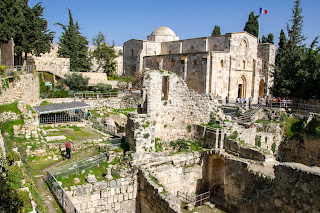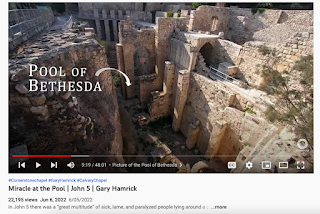When I first went to the Pool of Bethesda on my trip in 2017, we weren't there very long. It was like a pit stop on a cloudy day, and we didn't walk around it. I don't even know if I got pictures! Wow, that's unthinkable.
Since then, I've tried to go twice, but because of covid, the hours changed and it was always closed when I went (it was hard to find the hours online).
But finally, in the spring I got to go!
But that wasn't the first church built there, because the brochure the place gave me says that in 422-458 AD, a church was built to commemorate the healing of the paralytic. It extended over the medicinal baths and part of the pools. Some of that basilica still remains today.
By the time of the Persian invasion, around 614, everything was destroyed and left mostly abandoned through the Umayyad and Abbasid Caliphs. It wasn't until the Crusades in 1140 that a small monastery was built on the ruins of the 7th century chapel.
Then, the property changed hands again in 1192 after the conquest of Saladin. It became a school for Islamic law until it was abandoned under Ottoman rule and then given as a gift to France after the Crimean War (as Napoleon III helped the Ottomans). And it was given to the Missionaries of Africa (White Fathers) founded in 1878... and has remained in that ownership until this day.
So that's a lot of history, and most of it, I don't care about a lot... but I do care about 1 thing: Jesus was here, and He healed here! There is where He healed the paralytic in John 5!!!
As I've talked about before, I am a BIG fan of The Chosen, and I love that this show featured this story in Season 2! It's extra cool watching the episode after having been here... you can literally 'see' it! If you haven't watched the episode, go do it now! And the rest of the show because it is AWESOME!























